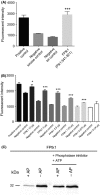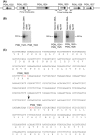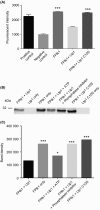Characterization of a bacterial tyrosine kinase in Porphyromonas gingivalis involved in polymicrobial synergy
- PMID: 24811194
- PMCID: PMC4082711
- DOI: 10.1002/mbo3.177
Characterization of a bacterial tyrosine kinase in Porphyromonas gingivalis involved in polymicrobial synergy
Abstract
Interspecies communication between Porphyromonas gingivalis and Streptococcus gordonii underlies the development of synergistic dual species communities. Contact with S. gordonii initiates signal transduction within P. gingivalis that is based on protein tyrosine (de)phosphorylation. In this study, we characterize a bacterial tyrosine (BY) kinase (designated Ptk1) of P. gingivalis and demonstrate its involvement in interspecies signaling. Ptk1 can utilize ATP for autophosphorylation and is dephosphorylated by the P. gingivalis tyrosine phosphatase, Ltp1. Community development with S. gordonii is severely abrogated in a ptk1 mutant of P. gingivalis, indicating that tyrosine kinase activity is required for maximal polymicrobial synergy. Ptk1 controls the levels of the transcriptional regulator CdhR and the fimbrial adhesin Mfa1 which mediates binding to S. gordonii. The ptk1 gene is in an operon with two genes involved in exopolysaccharide synthesis, and similar to other BY kinases, Ptk1 is necessary for exopolysaccharide production in P. gingivalis. Ptk1 can phosphorylate the capsule related proteins PGN_0224, a UDP-acetyl-mannosamine dehydrogenase, and PGN_0613, a UDP-glucose dehydrogenase, in P. gingivalis. Knockout of ptk1 in an encapsulated strain of P. gingivalis resulted in loss of capsule production. Collectively these results demonstrate that the P. gingivalis Ptk1 BY kinase regulates interspecies communication and controls heterotypic community development with S. gordonii through adjusting the levels of the Mfa1 adhesin and exopolysaccharide.
Keywords: Community; Porphyromonas gingivalis; periodontitis; polymicrobial synergy; tyrosine kinase.
© 2014 The Authors. MicrobiologyOpen published by John Wiley & Sons Ltd.
Figures







References
-
- Bechet E, Guiral S, Torres S, Mijakovic I, Cozzone AJ, Grangeasse C. Tyrosine-kinases in bacteria: from a matter of controversy to the status of key regulatory enzymes. Amino Acids. 2009;37:499–507. - PubMed
-
- Cozzone AJ. Role of protein phosphorylation on serine/threonine and tyrosine in the virulence of bacterial pathogens. J. Mol. Microbiol. Biotechnol. 2005;9:198–213. - PubMed
Publication types
MeSH terms
Substances
Grants and funding
LinkOut - more resources
Full Text Sources
Other Literature Sources
Molecular Biology Databases
Miscellaneous

